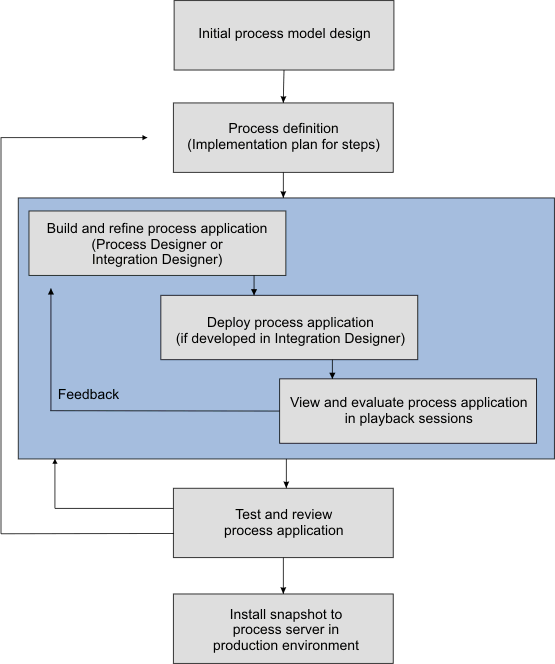The process application life cycle includes installing, administering, and undeploying snapshots. Versioning considerations are also part of the life cycle.
When developing processes, you can take full advantage of the iterative approach supported by the tools within the Process Designer. Processes evolve over time, initially from a development state, to testing, and then on to production. Even in production, your processes might continue to evolve because of changing needs. Being prepared for the ongoing life cycle of your processes is important and will help you design effectively from the outset.
The following figure illustrates an iterative approach to process development.

| Environment | Description |
|---|---|
| Development | Build and refine your process applications in IBM® Process Designer. Create your process models and implement the steps in those models using the Designer. Using the Inspector, demonstrate your development progress in playback sessions so that you can quickly evaluate and refine your prototype. Using the Process Center console, install your process applications on test or production process servers. |
| Test | Using the Process Center console, install your process applications on the Process Server in your test environment to implement formal quality assurance tests. You can use the Inspector to help verify and resolve issues. |
| Production | When all issues reported from formal testing are resolved, use the Process Center console to install your process applications on the Process Server in your production environment. You can use the Inspector to investigate and resolve any issues reported in your production environment. |
Release and installment strategies
To ensure the process applications that you implement and install meet the quality standards of your organization, consider defining a release and installment strategy. When you have identified the goals and requirements for release and installment of new and updated process applications, you can automate the processes required to approve and launch the programs.
For example, you might want to route a process to several different managers across different reporting structures in your organization. Only after each manager signs off on the new or updated process can it be installed in your production environment and rolled out to end users. You can create and implement the steps involved in such a review in IBM Business Process Manager Advanced to ensure that all corporate guidelines have been satisfied and that you have the required signatures. The final step in the review might be notification to the IT team that the approved process application is ready for installation.